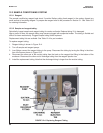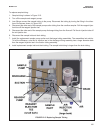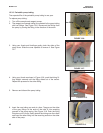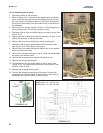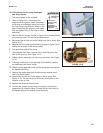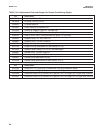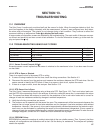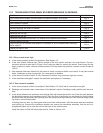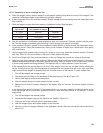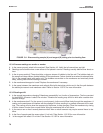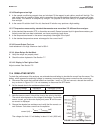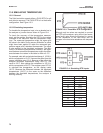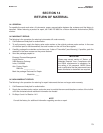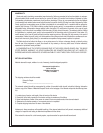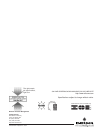
72
MODEL TCL SECTION 13
TROUBLESHOOTING
Temp. (°C) Pt 100 (Ω)
0 100.0
10 103.9
20 107.8
25 109.7
30 111.7
40 115.5
50 119.4
60 123.2
70 127.1
80 130.9
85 132.8
90 134.7
100 138.5
13.5 SIMULATING TEMPERATURE
13.5.1 General.
The 54eA controller accepts either a Pt100 RTD (for pH
and chlorine sensors). The Pt100 RTD is in a three-wire
configuration. See Figure 13-3.
13.5.2 Simulating temperature
To simulate the temperature input, wire a decade box to
the analyzer or junction box as shown in Figure 13-4.
To check the accuracy of the temperature measure-
ment, set the resistor simulating the RTD to the values
indicated in the table and note the temperature read-
ings. The measured temperature might not agree with
the value in the table. During sensor calibration an offset
might have been applied to make the measured tem-
perature agree with a standard thermometer. The offset
is also applied to the simulated resistance. The Solu
Comp II is measuring temperature correctly if the differ-
ence between measured temperatures equals the differ-
ence between the values in the table to within ±0.1°C.
For example, start with a simulated resistance of 103.9 Ω,
which corresponds to 10.0°C. Assume the offset from the
sensor calibration was -0.3 Ω. Because of the offset, the
analyzer calculates temperature using 103.6 Ω. The
result is 9.2°C. Now change the resistance to 107.8 Ω,
which corresponds to 20.0°C. The analyzer uses 107.5 Ω
to calculate the temperature, so the display reads
19.2°C. Because the difference between the displayed
temperatures (10.0°C) is the same as the difference
between the simulated temperatures, the analyzer is
working correctly.
FIGURE 13-3. Three-Wire RTD Configuration.
Although only two wires are required to connect
the RTD to the analyzer, using a third (and some-
times fourth) wire allows the analyzer to correct
for the resistance of the lead wires and for
changes in the lead wire resistance with tempera-
ture.
FIGURE 13-4. Simulating RTD Inputs.



